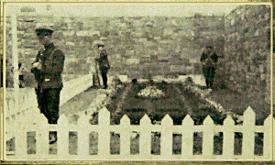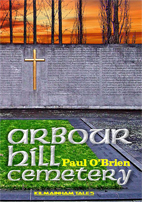
Directly north of The National Museum of Ireland at Collins Barracks is Arbour Hill Detention Centre. Built in 1835 and redesigned in 1845, it was the smallest of Dublin’s Victorian prisons.
Upon his arrival to take command on Friday, 28 April 1916, Maj Gen Sir John Grenfell Maxwell first issued a proclamation indicating he would take all measures necessary to quell the Rising.
His second command was to have a lime pit dug in the yard of Arbour Hill Prison (large enough for 100 bodies it was claimed) and that is where those executed were to be buried. He had already decided to execute the leaders.

(Above) A simple cross marks one of the two execution sites in the Stonebreakers' Yard, Kilmainham
The executions of the 14 leaders in Dublin were in Kilmainham Gaol from 3 to 12 May. Maxwell ordered the men were to be certified as dead by a medical officer and have a name label pinned to their breasts. The bodies would then be removed immediately to an ambulance, which, when full, was to drive to Arbour Hill Barracks where they were to be put in a grave alongside one another, covered in quicklime and the grave filled. One of the officers with the party was to keep a note of the identity of each body that was placed in the grave and a priest was to be available to attend “the funeral service”.
One of the Capuchin friars who ministered to the Volunteers during the Rising, and was with them at the end, Fr Columbus, went to Dublin Castle, then to the British military headquarters to assist in informing the Volunteers of the surrender.
Ultimately he was told to see General Maxwell and Patrick Pearse at Arbour Hill Prison and ask Pearse to rewrite his surrender note so it could be disseminated to the various garrisons.
Gen Maxwell received Fr Columbus courteously, and when he asked to be allowed to see Pearse and the others held there, his request was granted.
Fr. Columbus later wrote in the Capuchin Annual that Maxwell expressed his horror at the loss
of life and destruction of property, but said “Oh, but we will make those beggars pay for it”.
Fr Columbus replied “The blood of martyrs is the seed of martyrs”.
“Are you backing them up then?” asked Maxwell.
Concluding that prudence was the better part of valour, Columbus said nothing.
The stipulation about the burial of the remains in quicklime came from the very top because, from the outset, Maxwell was determined that the bodies of the executed men would not be released to their families. He feared that “Irish sentimentality will turn those graves into martyrs’ shrines to which annual processions etc will be made. [Hence] the executed rebels are to be buried in quicklime, without coffins”.

(above) A photo displayed in Arbour Hill of the original grave site in the corner of the prison yard.
The bodies of the executed 1916 leaders are buried in that pit of quicklime, and some DMP (Dublin Metropolitan Police) and British soldiers who witnessed the burials reported that they were buried in the order in which they were executed.
Behind the pit where they are entombed is a wall with the Proclamation of the Irish Republic inscribed in Irish and English.

None of the men buried there is commemorated in epitaph. Though their names are etched in the concrete surrounding the grave (see right), the mass grave in Arbour Hill is unmarked and identifiable only by its proximity to the wall and the flagpoles there. There is no eternal flame, no individual tributes to the executed men.
The graves are located under a low mound on a terrace of Wicklow granite in what was once the old prison yard. A limestone wall on which their names are inscribed in Irish and English surrounds the gravesite.

On the prison wall opposite the gravesite is a plaque with the names of other people who gave their lives in 1916.
Annually at Easter there is a commemoration, but otherwise there is no indication that the graves of the leaders of the Rising are held within the Prison walls.
Other than the little-publicised annual
commemoration, Arbour Hill is seldom mentioned for anything else.
From Patrick Pearse, the first executed, to James Connolly, the last, the 14 men executed in Dublin were shot in the Stonebreakers’ Yard of Kilmainham Gaol. Ask any 12 year old child in the country about the Rising, and he/she’ll tell you about Connolly being tied to a chair because he was mortally wounded and too ill to stand – then shot where he sat. But ask most Irish people what happened to Connolly’s body and those of the other executed leaders, and less is known.
Simply, the bodies of the men were thrown onto the back of a truck and taken to Arbour Hill, where they were dumped, without rite or coffin, into a pit and had quicklime poured over them.
Each of the men’s families had requested that their executed bodies be released to them, but General Maxwell made a decision not to concede to their wishes for fear that the men’s graves might become a place of pilgrimage or, worse, a rallying point for further insurrection.
The majority of the men executed for their part in the Easter insurrection were deeply committed Catholics – even Connolly received Communion from Capuchin Fr Aloysius – and there is no doubt that their Catholic faith meant a great deal to the executed men. And though Maxwell ordered a priest to be available, no priest escorted the executed bodies from Kilmainham to Arbour Hill, and no clergy was there when the men’s bodies were dumped into the quicklime pit.
They were buried in unconsecrated ground, in the final insult to their leadership.
(c) 2014 Joe Connell


Read more about the cemetery and it's history in Paul O'Brien's "Arbour Hill Cemetery" in the Kilmainham Tales series. Details here

Return to 1916 homepage
